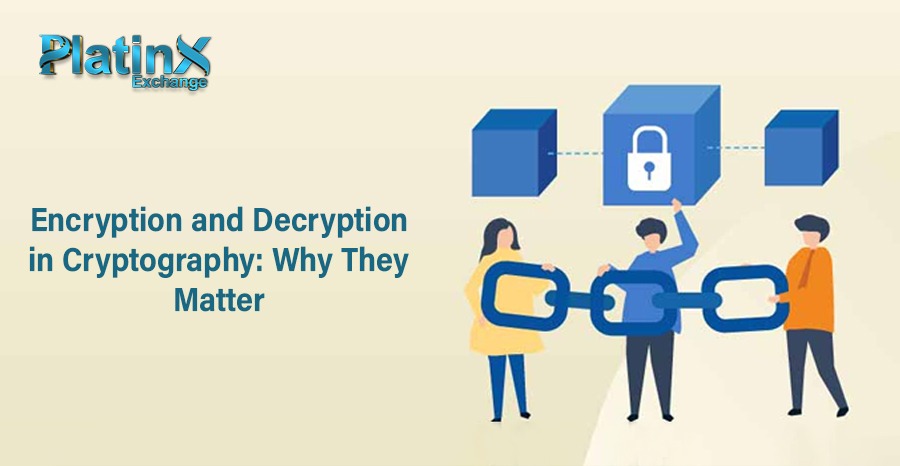Cryptography is the science of securing information by transforming it into an unreadable form that can only be accessed by authorized parties. Encryption and decryption in cryptography are the two essential functionalities that enable this process. In this blog post, we will explore what encryption and decryption are, how they work, and why they are important for data security and privacy.
What is Encryption?
Encryption is the process of converting a normal message (plaintext) into a meaningless message (ciphertext) using an algorithm and a key. The algorithm is a set of rules or instructions for the encryption process, and the key is a random string of bits that determines the output of the algorithm. The key is usually kept secret and shared only between the sender and the receiver of the message.
The purpose of encryption is to protect the confidentiality of data by making it unintelligible to anyone who does not have the key. For example, if you want to send an email to your friend, you can encrypt it with a key that only you and your friend know. This way, even if someone intercepts your email, they will not be able to read it without the key.
Types of Encryption: Symmetric and Asymmetric.
- Symmetric Encryption: Imagine two padlocks using the same key. Both parties use the same key to encrypt and decrypt information, making it efficient for secure communication between two trusted individuals.
- Asymmetric Encryption: Picture two unique keys, like a lock and a key. One key (public) is like a billboard, accessible to everyone, while the other (private) is closely guarded. Everyone can encrypt information using the public key, but only the holder of the private key can decrypt it, providing secure communication even with untrusted parties.
What is Decryption?
Decryption is the process of converting a meaningless message (ciphertext) into its original form (plaintext) using the same algorithm and key that were used for encryption. Decryption is the reverse of encryption and restores the data to its original state.
The purpose of decryption is to access the data that was encrypted and verify its authenticity and integrity. For example, if you receive an encrypted email from your friend, you can decrypt it with the key that you and your friend share. This way, you can read the email and make sure that it was not tampered with or modified by anyone.
Decryption can be done using either symmetric or asymmetric keys, depending on the type of encryption that was used. Symmetric decryption uses the same key that was used for encryption, whereas asymmetric decryption uses the private key that corresponds to the public key that was used for encryption.
Why Encryption and Decryption Matter?
Encryption and decryption in Cryptography are important for data security and privacy for several reasons. Some of them are:
- Encryption and decryption protect the data from unauthorized access and disclosure. By encrypting the data, only the intended recipients can access it and read it. This prevents hackers, eavesdroppers, and other malicious actors from stealing or misusing the data.
- Encryption and decryption ensure data integrity and authenticity. By decrypting the data, the recipients can verify that the data was not altered or corrupted during transmission or storage. This prevents data tampering, forgery, and impersonation.
- Encryption and decryption enable secure communication and transactions. By encrypting and decrypting the data, the sender and the receiver can exchange information and perform actions without exposing their identities or sensitive information. This enables online activities such as banking, shopping, voting, and messaging.
Encryption and Decryption in Cryptography FAQs
1. Is encryption always perfect?
While powerful, encryption isn’t infallible. Weak algorithms, poor key management, and software vulnerabilities can still make data vulnerable. It’s important to choose strong encryption methods and practice good security hygiene.
2. Do all online services use encryption?
Unfortunately, not all do. Look for signs like “HTTPS” in the website address and a padlock symbol to ensure your data is being encrypted. Be cautious about entering sensitive information on websites lacking these indicators.
3. Can governments break encryption?
Some governments possess sophisticated technologies that can potentially crack certain types of encryption. However, strong encryption with complex algorithms remains highly secure, making it a valuable tool for protecting privacy and security.
4. Does using encryption make me suspicious?
Using encryption is nothing to be worried about! It’s a standard practice for protecting sensitive information, and many individuals and organizations rely on it for everyday activities like online banking or messaging.
5. What can I do to protect my data beyond encryption?
Using strong passwords, enabling two-factor authentication, and keeping software updated are crucial steps to boost your digital security. Additionally, be mindful of what information you share online and only use trusted services.
6. Where can I learn more about cryptography?
There are many online resources available! The Indian government’s National Crypto Policy website, educational platforms like Coursera, and online communities focused on cybersecurity offer valuable information and learning opportunities.
7. How will encryption and decryption evolve in the future?
The field of cryptography is constantly evolving, with new algorithms and methods emerging to address emerging threats. Quantum computing poses new challenges, but advancements in post-quantum cryptography are ensuring continued data protection in the future.
Conclusion
Encryption and decryption in cryptography are the core functionalities that enable data security and privacy. Encryption is the process of converting a normal message into a meaningless message using an algorithm and a key, and decryption is the process of converting a meaningless message into its original form using the same algorithm and key. Encryption and decryption can be done using either symmetric or asymmetric keys, depending on the type of encryption that was used. Encryption and decryption are important for data security and privacy because they protect the data from unauthorized access and disclosure, ensure data integrity and authenticity, and enable secure communication and transactions. Encryption and decryption are widely used in various domains and applications, such as the Internet, cloud, blockchain, and IoT.

